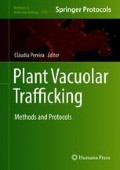Abstract
Chemical compounds are useful to perturb biological functions in the same way as classical genetic approaches take advantage of mutations at the DNA level to perturb gene function. The use of bioactive chemicals currently called chemical genetic is especially valuable for cell biology. Chemical genetic approaches allow perturbations of cellular processes post-germination in a given time window controlling the severity of the effect by modifying or modulating the dose and/or the period of the treatment. Additionally, compounds can be applied directly to different mutants and translational fluorescent reporters/marker lines, expanding the repertoire of experimental setups addressing cell biology research. In this chapter, we describe standard protocols to visualize vacuole morphology and trafficking to the vacuole and the use of bioactive compounds as a proxy to study these biological processes.
Access this chapter
Tax calculation will be finalised at checkout
Purchases are for personal use only
References
Frigerio L, Hinz G, Robinson DG (2008) Multiple vacuoles in plant cells: rule or exception? Traffic 9:1564–1570. https://doi.org/10.1111/j.1600-0854.2008.00776.x
Pedrazzini E, Komarova NY, Rentsch D, Vitale A (2013) Traffic routes and signals for the Tonoplast. Traffic 14:622–628. https://doi.org/10.1111/tra.12051
Xiang L, Etxeberria E, Van Den Ende W (2013) Vacuolar protein sorting mechanisms in plants. FEBS J 280:979–993. https://doi.org/10.1111/febs.12092
Matsuoka K, Bassham DC, Raikhel NV, Nakamura K (1995) Different sensitivity to wortmannin of two vacuolar sorting signals indicates the presence of distinct sorting machineries in tobacco cells. J Cell Biol 130:1307–1318. https://doi.org/10.1083/jcb.130.6.1307
Norambuena L, Tejos R (2017) Chemical genetic dissection of membrane trafficking. Annu Rev Plant Biol 68:197–224
Kleine-Vehn J, Leitner J, Zwiewka M et al (2008) Differential degradation of PIN2 auxin efflux carrier by retromer-dependent vacuolar targeting. Proc Natl Acad Sci U S A 105:17812–17817. https://doi.org/10.1073/pnas.0808073105
Alvarez AA, Han SW, Toyota M et al (2016) Wortmannin-induced vacuole fusion enhances amyloplast dynamics in Arabidopsis zigzag1 hypocotyls. J Exp Bot 67:6459–6472. https://doi.org/10.1093/jxb/erw418
Zouhar J, Hicks GR, Raikhel NV (2004) Sorting inhibitors (Sortins): chemical compounds to study vacuolar sorting in Arabidopsis. Proc Natl Acad Sci U S A 101:9497–9501. https://doi.org/10.1073/pnas.0402121101
Rosado A, Hicks GR, Norambuena L et al (2011) Sortin1-hypersensitive mutants link vacuolar-trafficking defects and flavonoid metabolism in Arabidopsis vegetative tissues. Chem Biol 18:187–197. https://doi.org/10.1016/j.chembiol.2010.11.015
Pérez-Henríquez P, Raikhel NV, Norambuena L (2012) Endocytic trafficking towards the vacuole plays a key role in the auxin receptor SCFTIR-independent mechanism of lateral root formation in A. thaliana. Mol Plant 5:1195–1209. https://doi.org/10.1093/mp/sss066
Dejonghe W, Kuenen S, Mylle E et al (2016) Mitochondrial uncouplers inhibit clathrin-mediated endocytosis largely through cytoplasmic acidification. Nat Commun 7:11710. https://doi.org/10.1038/ncomms11710
Ortiz-Zapater E, Soriano-Ortega E, Marcote MJ et al (2006) Trafficking of the human transferrin receptor in plant cells: effects of tyrphostin A23 and brefeldin a. Plant J 48:757–770. https://doi.org/10.1111/j.1365-313X.2006.02909.x
Zhang C, Brown MQ, van de Ven W et al (2015) Endosidin2 targets conserved exocyst complex subunit EXO70 to inhibit exocytosis. Proc Natl Acad Sci U S A:E41–E50. https://doi.org/10.1073/pnas.1521248112
Rojas-Pierce M, Titapiwatanakun B, Sohn EJ et al (2007) Arabidopsis P-Glycoprotein19 participates in the inhibition of Gravitropism by Gravacin. Chem Biol 14:1366–1376. https://doi.org/10.1016/j.chembiol.2007.10.014
Rivera-Serrano EE, Rodriguez-Welsh MF, Hicks GR, Rojas-Pierce M (2012) A small molecule inhibitor partitions two distinct pathways for trafficking of Tonoplast intrinsic proteins in Arabidopsis. PLoS One 7:1–11. https://doi.org/10.1371/journal.pone.0044735
Scheuring D, Schöller M, Kleine-Vehn J, Löfke C (2015) Vacuolar staining methods in plant cells. Methods Mol Biol 1242:83–92. https://doi.org/10.1007/978-1-4939-1902-4_8
Rodriguez-Furlán C, Hicks GR, Norambuena L (2014) Chemical genomics: characterizing target pathways for bioactive compounds using the endomembrane trafficking network. Methods Mol Biol 1174:317–328. https://doi.org/10.1007/978-1-4939-0944-5_22
Acknowledgments
This work was supported by grants numbers 1170950 to LN and 1171442 to RT from the Fondo Nacional de Investigación Científica y Tecnológica (Fondecyt).
Author information
Authors and Affiliations
Corresponding author
Editor information
Editors and Affiliations
Rights and permissions
Copyright information
© 2018 Springer Science+Business Media, LLC, part of Springer Nature
About this protocol
Cite this protocol
Tejos, R., Osorio-Navarro, C., Norambuena, L. (2018). The Use of Drugs in the Study of Vacuole Morphology and Trafficking to the Vacuole in Arabidopsis thaliana . In: Pereira, C. (eds) Plant Vacuolar Trafficking. Methods in Molecular Biology, vol 1789. Humana Press, New York, NY. https://doi.org/10.1007/978-1-4939-7856-4_11
Download citation
DOI: https://doi.org/10.1007/978-1-4939-7856-4_11
Published:
Publisher Name: Humana Press, New York, NY
Print ISBN: 978-1-4939-7855-7
Online ISBN: 978-1-4939-7856-4
eBook Packages: Springer Protocols

